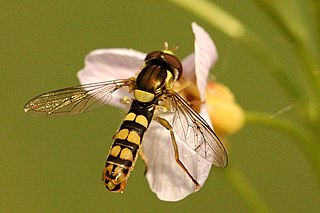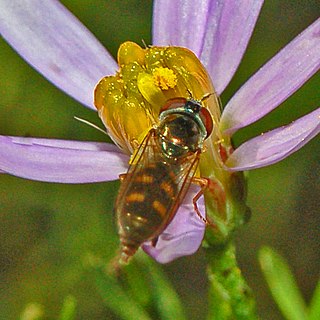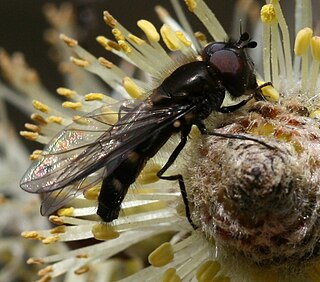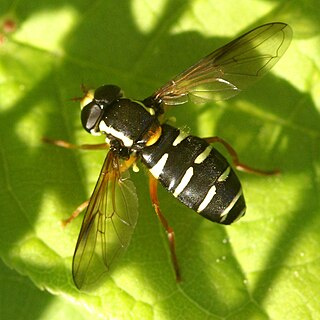
Syrphus ribesii is a very common Holarctic species of hoverfly. Its larvae feed on aphids. In common with many other species of hoverfly, males have the eyes meeting on the top of the head, whilst females have their eyes widely separated.

Platycheirus clypeatus is a species of hoverfly. It is found across the Palearctic and in the Nearctic. The larvae feed on aphids. Adults are usually found on the edges of woodland or scrub, heath or along hedgerows where they visit a wide range of flowers.

Platycheirus scambus is a species of hoverfly. It is a Holarctic species.

Platycheirus peltatus is a Palearctic species of hoverfly.

Sphaerophoria interrupta is a Palearctic species of hoverfly.

Platycheirus scutatus is a very common species of hoverfly. It is a Holarctic species.

Platycheirus fulviventris is a Palearctic species of hoverfly. It is found in many parts of Britain and Europe.

Sericomyia lappona, is a species of hoverfly. It is widespread throughout the Palearctic.

Platycheirus rosarum is a species of hoverfly found in the Palearctic. Like its close relative Platycheirus granditarsus, it can be found in marshy meadows and ditches; indeed, the two species can often be found together. The flight time is between May and October, though it peaks in abundance in June and July.

Pipizella viduata is a species of Hoverfly, from the family Syrphidae, in the order Diptera.

Parasyrphus vittiger is a species of hoverfly, from the family Syrphidae, in the order Diptera.

Anasimyia transfuga is a Palearctic species of hoverfly.

Parhelophilus consimilis is a Palearctic hoverfly.

Platycheirus angustatus is a species of hoverfly. It is found in many parts of the Palearctic, and in the Nearctic.
Platycheirus melanopsis is a species of hoverfly. It is found from northern Europe across to eastern Siberia. The larva is described by Rotheray
Platycheirus perpallidus is a species of hoverfly. It is a Holarctic species.
Platycheirus podagratus is a species of hoverfly. It is found in the Holarctic.
Melangyna arctica is a Holarctic species of hoverfly.

Melangyna quadrimaculata is a European species of hoverfly.

Philhelius citrofasciatus is a species of hoverfly found in grasslands from Ireland to western Siberia. The larvae live in Lasius ant colonies where they feed on the aphids tended by the ants. Prior to 2018, it was known under the genus name Xanthogramma, a junior synonym.
















